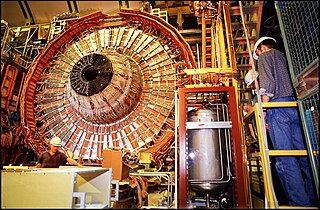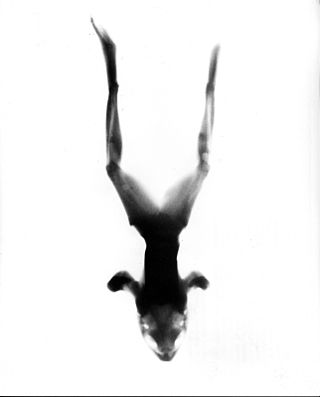Related Research Articles

The neutron is a subatomic particle, symbol
n
or
n0
, which has a neutral charge, and a mass slightly greater than that of a proton. Protons and neutrons constitute the nuclei of atoms. Since protons and neutrons behave similarly within the nucleus, and each has a mass of approximately one dalton, they are both referred to as nucleons. Their properties and interactions are described by nuclear physics. Protons and neutrons are not elementary particles; each is composed of three quarks.

Spectroscopy is the field of study that measures and interprets the electromagnetic spectra that result from the interaction between electromagnetic radiation and matter as a function of the wavelength or frequency of the radiation. In simpler terms, spectroscopy is the precise study of color as generalized from visible light to all bands of the electromagnetic spectrum.

A scintillation counter is an instrument for detecting and measuring ionizing radiation by using the excitation effect of incident radiation on a scintillating material, and detecting the resultant light pulses.
The fission-fragment rocket is a rocket engine design that directly harnesses hot nuclear fission products for thrust, as opposed to using a separate fluid as working mass. The design can, in theory, produce very high specific impulse while still being well within the abilities of current technologies.

DELPHI was one of the four main detectors of the Large Electron–Positron Collider (LEP) at CERN, one of the largest particle accelerators ever made. Like the other three detectors, it recorded and analyzed the result of the collision between LEP's colliding particle beams. The specific focus of DELPHI was on particle identification, three-dimensional information, high granularity (detail), and precise vertex determination.

Neutron detection is the effective detection of neutrons entering a well-positioned detector. There are two key aspects to effective neutron detection: hardware and software. Detection hardware refers to the kind of neutron detector used and to the electronics used in the detection setup. Further, the hardware setup also defines key experimental parameters, such as source-detector distance, solid angle and detector shielding. Detection software consists of analysis tools that perform tasks such as graphical analysis to measure the number and energies of neutrons striking the detector.

The Lazarus effect refers to semiconductor detectors; when these are used in harsh radiation environments, defects begin to appear in the semiconductor crystal lattice as atoms become displaced because of the interaction with the high-energy traversing particles. These defects, in the form of both lattice vacancies and atoms at interstitial sites, have the effect of temporarily trapping the electrons and holes which are created when ionizing particles pass through the detector. Since it is these electrons and holes drifting in an electric field which produce a signal that announces the passage of a particle, when large amounts of defects are produced, the detector signal can be strongly reduced leading to an unusable (dead) detector.
A wavelength shifter is a photofluorescent material that absorbs higher frequency photons and emits lower frequency photons. The material absorbs one photon, and emits one or multiple lower-energy photons. The relaxation time of the excited molecule is usually in the order of nanoseconds.
A clover detector is a gamma-ray detector that consists of 4 coaxial N-type high purity germanium (Ge) crystals each machined to shape and mounted in a common cryostat to form a structure resembling a four-leaf clover.

In particle detectors a detection of internally reflected Cherenkov light (DIRC) detector measures the velocity of charged particles and is used for particle identification. It is a design of a ring imaging Cherenkov detector where Cherenkov light that is contained by total internal reflection inside the solid radiator has its angular information preserved until it reaches the light sensors at the detector perimeter.
FLUKA is a fully integrated Monte Carlo simulation package for the interaction and transport of particles and nuclei in matter. FLUKA has many applications in particle physics, high energy experimental physics and engineering, shielding, detector and telescope design, cosmic ray studies, dosimetry, medical physics, radiobiology. A recent line of development concerns hadron therapy.

Radiation Portal Monitors (RPMs) are passive radiation detection devices used for the screening of individuals, vehicles, cargo or other vectors for detection of illicit sources such as at borders or secure facilities. Fear of terrorist attacks with radiological weapons spurred RPM deployment for cargo scanning since 9/11, particularly in the United States.

Stefan Janos is a Slovak-Swiss university physicist and professor, founder of very low temperature physics in Slovakia.

Neutron imaging is the process of making an image with neutrons. The resulting image is based on the neutron attenuation properties of the imaged object. The resulting images have much in common with industrial X-ray images, but since the image is based on neutron attenuating properties instead of X-ray attenuation properties, some things easily visible with neutron imaging may be very challenging or impossible to see with X-ray imaging techniques.
The Virtual Instrumentation Tool for the ESS (VITESS) is an open source software package for the simulation of neutron scattering experiments. The software is maintained and developed by the Helmholtz-Zentrum Berlin für Materialien und Energie (HZB), the former Hahn-Meitner-Institur HMI, and available for Windows, Linux and Macintosh on the VITESS homepage. It is widely used for simulation of existing neutron scattering instruments as well as for the development of new instruments.

The nested neutron spectrometer (NNS) is a tool used for neutron spectroscopy. The NNS is used to measure the energy spectrum of neutrons in a neutron field. This type of detector is used in both research facilities (for characterization of neutron fields) and workplaces, where neutron radiation maybe encountered, for radiation protection purposes. Due to the difficulty associated with the detection of neutrons, the NNS is one of the few pieces of equipment capable of accurately determining the characteristics of a neutron field.

Kim Sun-kee is a South Korean physicist. He is professor in Seoul National University and director of the Korea Invisible Mass Search. He was the first director of the Rare Isotope Science Project within the Institute for Basic Science and is a member of the Korean Academy of Science and Technology.

The ISOLDE Solenoidal Spectrometer (ISS) experiment is a permanent experimental setup located in the ISOLDE facility at CERN. By using an ex-MRI magnet, heavy radioactive ion beams (RIBs) produced by the HIE-ISOLDE post-accelerator are directed at a light target and the kinematics of the reaction is measured. The purpose of the experiment is to measure properties of atomic nuclei replicating the conditions present in some astrophysical processes, such as the production of chemical elements in stars. The experiment will also produce results that provide a better understanding of nucleon-nucleon interactions in highly-unstable, very radioactive (exotic) nuclei.
Associated particle imaging (API) is a three dimensional imaging technique that maps the distribution of elements within an object. In associated particle imaging, deuterium-tritium fusion reactions each produce a fast neutron and an associated particle, which travel in opposite directions in the center-of-mass frame. By measuring the timing and position of the associated particle, the trajectory of the neutron may be inferred. The neutron may then enter an object of interest where it is likely to undergo inelastic scattering. This produces one or more gamma-rays of specific energies dependent on the element that the neutron scatters off of. By measuring the gamma-ray energy, the element may be identified. The timing of the gamma-ray coinciding with an associated particle allows the 3D imaging of an object's elemental composition. This technique has applications in agriculture, national security, and other areas.
References
- ↑ "ISIS - Neutron spectroscopy". www.isis.stfc.ac.uk. Archived from the original on 2009-10-25.
- ↑ Brooks, F. D; Klein, H (2002-01-01). "Neutron spectrometry—historical review and present status". Nuclear Instruments and Methods in Physics Research Section A: Accelerators, Spectrometers, Detectors and Associated Equipment. Int. Workshop on Neutron Field Spectrometry in Science, Technology and Radiation Protection. 476 (1): 1–11. Bibcode:2002NIMPA.476....1B. doi:10.1016/S0168-9002(01)01378-X. ISSN 0168-9002.
- ↑ Ericsson, Göran (2019-02-27). "Advanced Neutron Spectroscopy in Fusion Research". Journal of Fusion Energy. 38: 330–355. doi: 10.1007/s10894-019-00213-9 .
- ↑ Goldhagen, P; Reginatto, M; Kniss, T; Wilson, J. W; Singleterry, R. C; Jones, I. W; Van Steveninck, W (2002-01-01). "Measurement of the energy spectrum of cosmic-ray induced neutrons aboard an ER-2 high-altitude airplane". Nuclear Instruments and Methods in Physics Research Section A: Accelerators, Spectrometers, Detectors and Associated Equipment. Int. Workshop on Neutron Field Spectrometry in Science, Technology and Radiation Protection. 476 (1): 42–51. Bibcode:2002NIMPA.476...42G. doi:10.1016/S0168-9002(01)01386-9. ISSN 0168-9002. PMID 12033224.